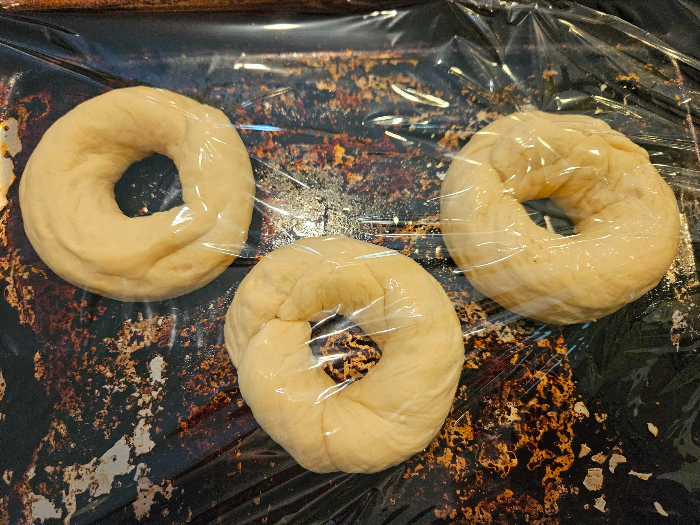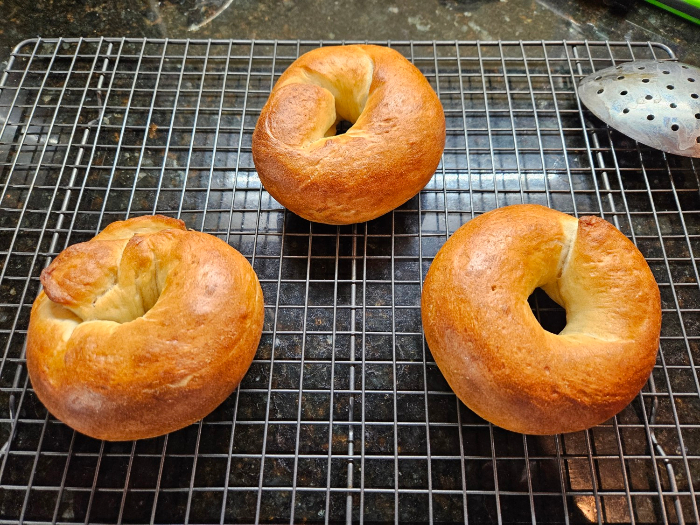Farewell, Sweet Concorde!
November 22nd, 2024I Thought Your Son was a Lady
I am now trying to make bagels for the second time. I started out with the King Arthur Baking recipe, and it had obvious flaws, like using at least 6 times as much yeast as any experienced baker would put in bread. It also had a hydration of 63%, which is far from the 55-58% recommended by other references. At 63%, you’re close to pizza territory, and pizza is nothing like a bagel. Pizza is softer and has big air holes.
I am now working with a 55% dough. I added more malt, I think. I was interrupted by a phone call, but I’m pretty sure I increased the malt by a third.
The dough is pretty hard. It’s so dry, it doesn’t stick to my fingers at all.
I decided to look at some videos featuring people who, unlike the King Arthur company, make bagels for a living. I was suspicious of King Arthur’s rising, resting, and shaping instructions.
King Arthur says to knead, proof for an hour and a half, cut in pieces, form bagel-weight balls, and let them rise for another 30 minutes. It says you then stick your finger in each ball and twirl the ball until you get a 1-1/2″ hole.
If you do this, you’re handling the dough a lot, beating it up, and you’re making it hard to get a nice shape.
The first rise will make the dough lumpy and soft, and when you try to form a ball, you get a ball that wants to bounce back and be lumpy again. If you try to twirl it later, it will stretch irregularly, give you a bagel which is thicker in some places than others. It seems like a stupid idea.
I decided to forget all that work. I took the dough from the Cuisinart and made three balls. I’m letting them rise for around an hour and 50 minutes. Then I plan to put holes in them and stretch them out. I may take one ball, roll it into a stick, and fasten the ends together to make a ring.
The professionals I watched didn’t do a lot of crazy steps. It generally goes like this: knead, rest a short time, cut and form into bagels.
Youtube shows New York bakers taking long strips of dough, wrapping them around their hands so the ends overlap, and rolling them until the ends merge, forming rings. There are also machines that turn dough into rings, though.
Baking is full of superstition and witchcraft. Face west when you add the yeast. Stand on one foot when you knead the dough. Use kosher salt, which is exactly the same thing as gentile salt. The problem is that most bakers will not challenge the useless fake wisdom. If a step worked for their grandparents, it must be necessary.
I like to weed out the nonsense. For example, I don’t really knead dough. I throw it in a Cuisinart with a chopping blade, and in 30-60 seconds, it’s perfect. There are still people out there claiming you have to break your back kneading dough for 10 minutes with your hands. It makes it taste like love! No, it doesn’t. You can’t taste love.
Most bakery bread is baked by illegal aliens who just got off the boat. Do you think they’re thinking about love when they do as they’re told? No, they’re thinking about ICE and vans with no windows.
I’m not sure 55% will work. I may move up to 58% next time. I’m sure 63% will not work, because it doesn’t work for me, and it looks like no one but King Arthur recommends it.
My first bagel batch was full of lumps and tears. I believe this next batch will be smooth and regular, like real bagels.
I’m using baking soda and salt in the water bath, and I’m not going to boil the bagels for three minutes this time.
I’m using high-gluten flour. Seems like an obvious choice.
The web says King Arthur makes a high-gluten flour called Sir Lancelot. You mix it with your other ingredients, turn your mixer on, swing on a chandelier, and kick the bride in the chest.
I don’t know why King Arthur didn’t recommend Sir Lancelot in its recipes, but this could go back to my theory that the people who write their recipes are not very good. They should call their bagels “bitter yeast rings.”
I don’t know if these new bagels will be better than the previous ones, but they can’t be much worse.
MORE
The dough rose nicely, and it is surprisingly soft for 55% hydration. It was very relaxed when I took it out of the oven, where it was rising.
I was going to try to shape the bagels the easy way, poking holes in the balls of dough and opening the holes up. But I decided to try doing what the pros do. I rolled the bagels by hand. It turned out to be much easier than I expected.
You take a doughball, mash it into a flat, long shape, like a rectangle, and then you roll the dough up, starting at one short side. Then you use your hands to roll and stretch it into a stick around 10″ long. After that, you put the ends in your palm, overlapping. You roll the dough back and forward to mash the ends together. You will get a fairly uniform ring of dough around your fingers. It will look a lot like a real bagel that was not made by a machine.
I’ll post a helpful video.
I’m letting the bagels relax a bit before I boil them.
They seem a little small. They weigh around 126 grams each, which should make fairly big bagels.
I believe the rolling is important because it will get rid of the big holes inside the dough. A bagel is supposed to be dense. I didn’t try to make them too perfect, because real bagels don’t look like perfect little O-rings.
Hoping for the best.
MORE
The bagels are cooling.
They look pretty much like bagels, although I did not do an adequate job of joining the ends on one stick of dough.
They’re too dark, at least for me. I should not have listened to people who said to bake at 450 or 500. I started these at 450, and within about 8 minutes, they were dark enough to take out. I had to leave them in so the insides cooked. I dropped the temperature to 400, and they still cooked too fast, so I went down to 350.
Apparently, there are a lot of people who like dark bagels, because a lot of recipes specify high temperatures. Next time, I’m going to try 400.
MORE
I tried a bagel.
It looks like a bagel, and it has a pretty good crust on it. Problems:
1. The crust is too dark. The baking instructions I found on the web can’t be right. The temperature is wrong.
2. The crust should be harder and chewier.
3. The crust doesn’t have the sweet taste bagel crusts should have. It’s more like a baguette. The recipes I looked up must not use enough malt powder for boiling.
4. The holes in the crumb are way too big, like a pizza. I believe I let the dough rise too long and this caused the problem, even though I used much less yeast than King Arthur’s bakers recommend. If I had used the amount they suggest, the bagels would look like balloons.
The plan:
1. Reduce the temperature to 400 next time.
2. Double the malt powder in the dough.
3. Add enough malt powder to the boil to make it a lot sweeter.
4. Boil the bagels for two minutes per side, not one.
5. Decrease the rise time.
This ought to get me closer.

